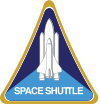STS-29
| Missionsemblem | |||||
|---|---|---|---|---|---|
 | |||||
| Missionsstatistik | |||||
| Missionsnavn: | STS-29 | ||||
| Rumagentur: | NASA | ||||
| Rumfærge: | Discovery (8) | ||||
| Antal besætningsmedlemmer: | 5 | ||||
| Affyringsrampe: | LC-39B (KSC) | ||||
| Opsendelse: | 13. marts 1989 | ||||
| Landing: | 18. marts 1989 | ||||
| Landet på: | Edwards Air Force Base | ||||
| Varighed: | 4 dage, 23 timer | ||||
| Foto af besætningen | |||||
 | |||||
| Navigation | |||||
| |||||
STS-29 (Space Transportation System-29) var Discoverys ottende rumfærge-mission. Opsendt 13. marts 1989 og vendte tilbage den 18. marts 1989.
Missionen satte kommunikationssatellitten Tracking and Data Relay Satellite (TDRS-4) i kredsløb[1].
Besætning

 Michael Coats (kaptajn)
Michael Coats (kaptajn)
 John Blaha (pilot)
John Blaha (pilot)
 James Bagian (1. missionsspecialist)
James Bagian (1. missionsspecialist)
 James Buchli (2. missionsspecialist)
James Buchli (2. missionsspecialist)
 Robert Springer (3. missionsspecialist)
Robert Springer (3. missionsspecialist)
Eksperimenter:
- 32 befrugtede hønseæg for at studere vægtløshedens indvirken på kyllingfostre.
- 40 rotter med meget små dele af deres ben taget af for at studere vægtløshedens indvirken på sårheling.
- Et eksperiment der kun en delvis lykkedes var et nyt kølesystem til rumstationen Freedom (Freedom udvikledes senere til Den Internationale Rumstation (ISS)).
Hovedartikler:
Eksterne henvisninger
- STS-29 NASA (engelsk)
- Tracking and Data Relay Satellite System (TDRSS) Arkiveret 20. marts 2009 hos Wayback Machine NASA (engelsk)
- ^ Tracking and Data Relay Satellite System (TDRSS)TDRS-D Arkiveret 12. december 2007 hos Wayback Machine (engelsk)
| ||||||||
| ||||||||||||||||||||
Medier brugt på denne side
Forfatter/Opretter: Kwamikagami, Licens: CC BY-SA 4.0
symbol of Mars. 16 × 16 pixel nominal dimensions, lines 2 pixel thick, square caps. Colour 75% blue: red=0 green=0 blue=191 (#0000BF).
Rotated and color enhanced version of original (ISS013-E-48788 (6 July 2006) --- The Space Shuttle Discovery approaches the International Space Station for docking but before the link-up occurred, the orbiter "posed" for a thorough series of inspection photos. Leonardo Multipurpose Logistics Module can be seen in the shuttle's cargo bay. Discovery docked at the station's Pressurized Mating Adapter 2 at 9:52 a.m. CDT, July 6, 2006.)
SVG version of PNG Space Shuttle Logo/Patch.
STS-29 Mission Insignia
The STS-29 patch was designed to capture and represent the energy and dynamic nature of this nation's space program as America continues to look to the future. The folded ribbon border, the first of its kind in the Shuttle patch series, gives a sense of three dimensional depth to the emblem. The stylistic orbital maneuvering system (ONS) burn symbolizes the powerful forward momentum of the Shuttle and a continuing determination to explore the frontiers of space. The colors of the U.S. flag are represented in the patch's basic red, white, and blue background. In the border, the seven stars between the STS-29 crew names are a tribute to the crew of Challenger.
STS-27 Mission Insignia
Five astronauts composed the STS-29 crew. Standing (left ot right) are James P. Bagian, mission specialist 1; Robert C. Springer, mission specialist 3; and James F. (Jim) Buchli, mission specialist 2. Seated (left to right) are John E. Blaha, pilot, and Michael L. Coats, commander. STS-29 launched aboard the Space Shuttle Discovery on March 13, 1989 at 9:57 am (EST). The primary payload was the Tracking and Data Relay Satellite- 4 (TDRS-4).
The STS-30 patch depicts the joining of NASA's manned and unmanned space programs. The sun and inner planets of our solar system are shown with the curve connecting Earth and Venus symbolizing the shuttle orbit, the spacecraft trajectory toward Venus, and its subsequent orbit around our sister planet. A Spanish caravel similar to the ship on the official Magellan program logo commemorates the 16th century explorer's journey and his legacy of adventure and discovery. Seven stars on the patch honor the crew of Challenger. The five-star cluster in the shape of the constellation Cassiopeia represent the five STS-30 crewmembers - Astronauts David Walker, Ronald Grabe, Norman Thagard, Mary Cleave and Mark Lee - who collectively designed the patch.









